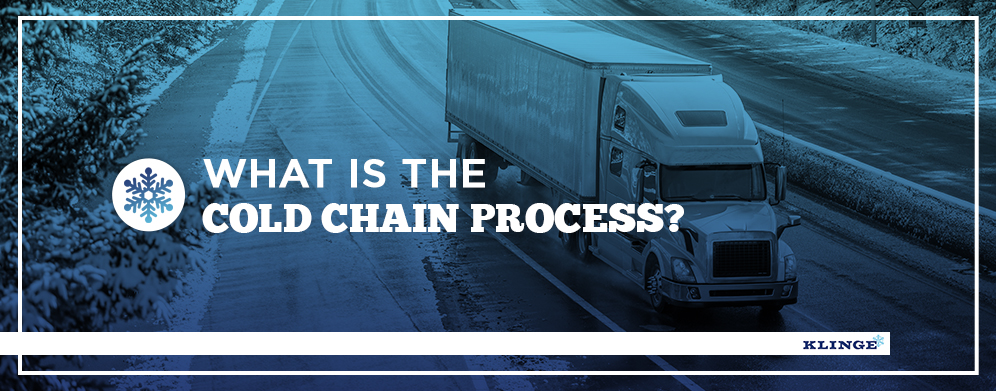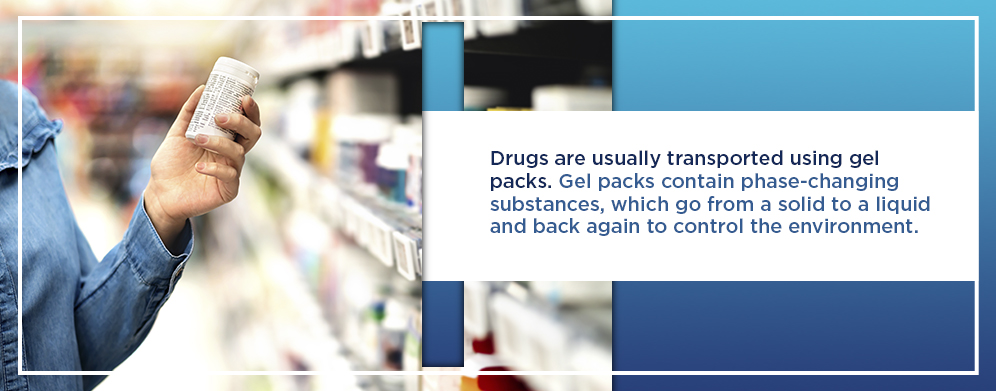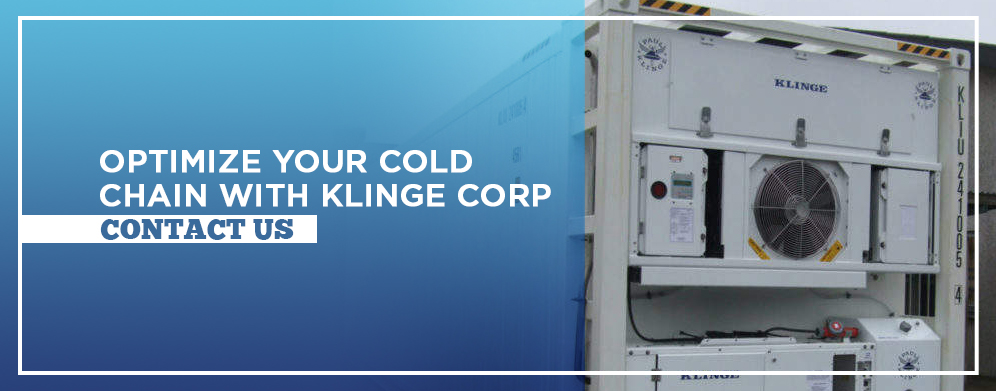Most of us are familiar with the term “supply chain.” Cold chain transportation or cold chain shipping is a variation of the standard supply chain, which moves products from production to the eventual user. It concerns the movement of chilled products at a temperature between 2° and 8°C — or 36° to 46°F — or at even lower temperatures ranging down to -70°C or -85°F. Cold chain transport is a temperature-controlled distribution chain used in highly regulated industries such as food and beverage, pharmaceuticals and chemicals.
Table of Contents
- What Are the Components of the Cold Chain?
- Why Is Efficient Cold Chain Transportation Important?
- Cold Chain Transport and the Pharmaceutical Industry
- How Is the Cold Chain System Important to Other Industries?
What Are the Components of the Cold Chain?
The three fundamental elements of the cold chain rely on cooling technology to maintain the integrity of shipped goods. These elements include the following:
- Product: Cold chain logistics involves getting temperature-sensitive goods from one place to another. The products need specific temperature and humidity conditions during the shipping process. Cooling systems bring the product to the appropriate temperature and, depending on the method and duration of the trip, cool the products in transit.
- Origin and destination: The places where the product originates and ends up are crucial to consider in the cold chain. The longer the physical distance, the more challenging it is to keep a regulated temperature. Once products arrive at the final market, whether it’s a grocery store or a local pharmacy, they will receive constant refrigeration. While in transport, however, the items may be cooled by gel packs or kept cool using insulation. In those cases, there may be higher chances for temperature fluctuation.
- Distribution: Cold transport vehicles, or reefers, move goods and maintain stable conditions as the products travel to their final destinations. Refrigerated shipping containers can support uninterrupted travel. Otherwise, a distribution network may rely on cold storage facilities along the route. Products may be stored in several refrigerated facilities along the supply chain. They may wait to ship overseas at a refrigerated warehouse at the origin, then arrive at an intermediate location for processing and distribution. Finally, they will be stored close to the destination market for distribution.
Active vs. Passive Cold Chain Packaging
There are two types of cold chain packaging systems: active and passive. Active systems consist of cold chain transport containers featuring advanced electric or battery-powered temperature controls. Active systems often have built-in cooling units or rely on dry ice as a coolant. A system pushes cool air from the refrigeration system into the main payload area. Active systems work better for larger shipments and offer greater security, which minimizes the risk of theft. Active refrigeration systems, in addition, offer greater security as they are not limited like dry ice systems to operation only for a certain amount of time until the dry ice would all be consumed and need to be replaced.
Passive packaging systems typically include polyurethane or polystyrene insulation or vacuum-insulated panels that can keep the product at a predetermined temperature for up to 96 hours or longer. Passive systems can maintain tighter temperatures than active systems and are not susceptible to internal freezing. Disadvantages of passive systems include the need to condition the refrigerant to specific requirements and more complex shipping configurations as well as the primary constraint of time — passive systems will fail at a 100% rate to maintain temperature if they do not arrive at the final destination within the required packaging specification.
Why Is Efficient Cold Chain Transportation Important?
The efficient management of a cold chain supply line is essential for maintaining the integrity of the product. Unlike shipping non-perishable products such as clothing or furniture, a break in the cold chain could result in damage or spoilage that makes the product unusable.
One example is the cold chain shipping of pharmaceuticals, many of which must be maintained at a precise temperature. A variation of more than one or two degrees could ruin an entire shipment and cost the manufacturer hundreds, thousands or even millions of dollars. For this reason, Klinge Corporation manufactures a line of cold chain containers designed for pharmaceutical and chemical industries.
Efficient cold chain transportation uses monitoring to track temperatures and reduces the number of hand-offs between the origin and destination. The cold chain industry has standardized temperature zones to maintain the products. A shipment will have one of five classifications, so any shipper or receiver knows how to store and manage the delivery:
- Banana: Bananas and many other tropical fruits undergo controlled ripening during transport. The category has a temperature range between 12° and 14°C. It is also used to store oranges, pineapples and potatoes.
- Pharmaceutical: Most pharmaceutical goods requiring temperature control must be kept between 2° and 8°C.
- Chill: The “chill” classification, with a range between 2° and 4°C, is used to transport many fruits, vegetables and fresh meat.
- Frozen: Frozen beef, poultry, pork, cakes and bread must stay between -10° and -20°C.
- Deep-frozen: Seafood, ice cream and other items requiring the coldest transport temperature are kept at -25° to -30°C.
Cold Chain Transport and the Pharmaceutical Industry
The cold chain in the pharmaceutical industry has been on a steady incline in recent years. Spending on biopharma cold chain logistics is projected to increase to $18.6 billion in 2022, up from $13.3 billion in 2016. Of the 57 new drugs approved by the FDA in 2017, 49% were temperature sensitive and 23% required refrigeration between 2° and 8°C. Some of the medicines that need cold chain transport are vaccines, some asthma aerosol inhalers and some insulins used to treat diabetes.
Biopharmaceuticals, or biologicals, such asblood or plasma, organs, tissue transplants or stem cells, also require storage between 2° and 8°C and some at temperatures down to -40°C to -45°C.
All parties in the pharmaceutical cold chain are responsible for keeping the items in a temperature-controlled environment. Failure to store drugs or biologicals properly can be a public health hazard, if not caught. A break in the cold chain can also result in significant financial losses. Pharmaceutical manufacturers, pharmacies, doctors and hospitals all have a responsibility to track the cold chain and ensure all drugs have been preserved.
Drugs are usually transported using gel packs. Gel packs contain phase-changing substances, which go from a solid to a liquid and back again to control the environment. They start frozen or refrigerated, then melt into liquids during transport while capturing escaping energy and maintaining their internal temperature.
Some biologicals — namely organs and tissues — must be kept frozen during transport. In these cases, dry ice or deep freezer systems can keep these items frozen for extended periods.
Klinge offers several other pharmaceutical and medical refrigeration units such as the Picture Frame Dual Refrigeration Unit, Dual Redundant Refrigeration Unit, and -5ºC to -25ºC Dual Redundant Refrigeration Unit.
How Is the Cold Chain System Important to Other Industries?
- Military: The U.S. Military also needs to control the temperature of its medical supplies. The cold chain becomes more complicated in military applications because goods often have to travel long distances to hard-to-reach, hot regions like Iraq and Afghanistan. The U.S. Army Medical Material Center, Europe (USAMMCE) ships over 25,000 pounds of cold chain medical products and vaccines that all must be delivered within 72 hours.
- Food and beverages: Temperature is crucial for transporting produce, meat and seafood. Any break in the cold chain can lead to rotting, bacteria or mold. Many fruits are ripened during shipment, so a stable temperature is vital. The way meats are frozen also affects their integrity. A fast freezing rate achieved through blast freezing forms smaller ice crystals, while a slow freezing process will form larger ice crystals that can damage meat’s cellular structure and change its texture. A gradual, unintended thawing can have the same effect. The FDA has strict regulations about how food can be transported, including temperature and sanitation requirements for vehicles.
- Oil and gas: In the oil and gas industry, compliance with ATEX Directive 2014/34/EU protects people, the environment and property. The sector needs explosion-proof refrigerated containers safe to use on oil rigs, oil tankers and offshore locations.
- Chemical: Many hazardous chemicals are susceptible to exothermic reactions. As heat escapes from chemical goods, a spark, flame or explosion can occur, which can harm people nearby and ruin the cargo.
Optimize Your Cold Chain With Klinge Corp
As a leading manufacturer of high-quality cold chain transport containers, Klinge Corporation can help you understand cold chain logistics and how they benefit your shipping processes. We have extensive experience in providing reliable solutions for companies in industries such as pharmaceuticals, oil and gas, food and military.
Our refrigerated shipping containers are very dependable, so you can trust us when temperature control has a direct impact on your bottom line. We offer Dual Redundant Refrigerated Containers with backup power supplies for pharmaceuticals and chemical transportation for increased safety, regulatory compliance and product integrity.
We also offer cooling containers, tank containers, freezer units, and blast freezing containers for the seafood and meat processing industry for higher quality meats and easier transportation. We can meet all industry standards and are always innovating solutions to make cold chain transport more accessible and more reliable in your industry. Contact us for more information today, or request a quote to discuss how we can serve your cold transport needs.



